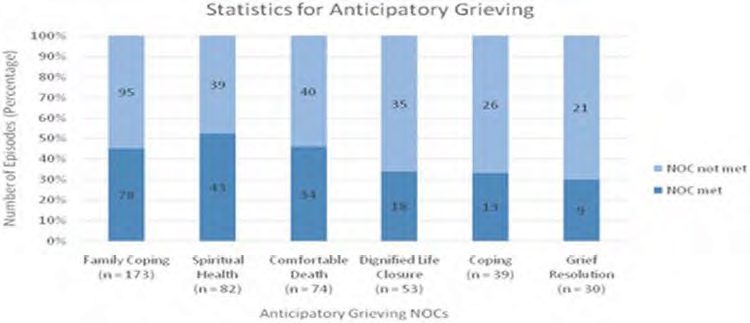Outcomes for End-of-Life Patients with Anticipatory Grieving: Insights from Practice with Standardized Nursing Terminologies within an Interoperable Internet-based Electronic Health Record
June 1st, 2017
Categories: Applications, Human Factors, User Groups, Visual Analytics, Visual Informatics, Human Computer Interaction (HCI)

Authors
Johnson J. A., Lodhi M. K., Cheema U., Stifter, J., Dunn-Lopez, K., Yao, Y., Johnson, A., Keenan, G. M., Ansari, R., Khokar, A., Wilkie, D.About
Although grief is often associated with death, receiving a diagnosis of a terminal disease for oneself or a loved one also unleashes an onslaught of emotions for the individual and caregivers. Sorrow, grief, fear, anger, and anxiety may fill the time between diagnosis and loss. Rando defines anticipatory grief as “the phenomenon encompassing the processes of mourning, coping, interaction, planning, and psychosocial reorganization that are stimulated and begun in part in response to the awareness of the impending loss of a loved one (death) and in the recognition of associated losses in the past, present, and future.” Though its topical presence in the literature has increased over the past half-century, the continued discrepant findings highlight the importance of further research into the outcomes of those experiencing anticipatory grief. The purpose of our study was to examine the outcomes of hospitalized end-of-life patients with anticipatory grief.
Globally, 8 million people die of cancer every year. Coupled with the 7.7 million new annual diagnoses of dementia worldwide as well as the millions who lose family members to other terminal diseases, the apparent impact of anticipatory grief on the lives of the patient and caregivers is colossal. Research has been contradictory in its findings regarding of the long-term effects of anticipatory grief. Some argue that anticipatory grief may lead to a prolonged grief reaction, whereas some argue that it aids recovery from the grief process after death, and others that it is not related to post-death bereavement.5 One cited contributory reason to the contradictory findings is the lack of an operational definition. An underutilized solution is the NANDA International's (NANDA-I, formerly North American Nursing Diagnosis Association International) operational definition of Anticipatory Grieving, which defines the concept as an action state of engagement in grief work before the death or loss occurs (Table 1), instead of as a non-gerundial noun, anticipatory grief, which is used in much of the literature. In this article, we use Anticipatory Grieving (AG) to represent the NANDA-I diagnosis, and anticipatory grief to represent the concept, which is similar to but not necessarily conforming to the defining characteristics of AG (Table 1). Researchers have demonstrated that nurses, well-trained in the use of clinical decision support, accurately use standardized nursing terms and measures for nursing diagnoses, interventions, and outcomes in the electronic health record (EHR), which makes it possible to evaluate the impact of care provided to patients with AG.
Keywords: electronic health record; nursing; anticipatory grieving; palliative care; grief
Resources
URL
Citation
Johnson J. A., Lodhi M. K., Cheema U., Stifter, J., Dunn-Lopez, K., Yao, Y., Johnson, A., Keenan, G. M., Ansari, R., Khokar, A., Wilkie, D., Outcomes for End-of-Life Patients with Anticipatory Grieving: Insights from Practice with Standardized Nursing Terminologies within an Interoperable Internet-based Electronic Health Record, Journal of Hospice and Palliative Nursing, vol 19, no 3, pp. 223-231, June 1st, 2017. https://doi.org/10.1097/NJH.0000000000000333